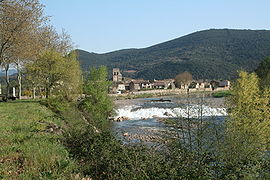Villemagne-l'Argentière
| Villemagne-l'Argentière | ||
|---|---|---|
| Commune | ||

General view from across the Mare River
|
||
|
||
| Coordinates: 43°37′07″N 3°07′13″E / 43.6186°N 3.1203°ECoordinates: 43°37′07″N 3°07′13″E / 43.6186°N 3.1203°E | ||
| Country | France | |
| Region | Occitanie | |
| Department | Hérault | |
| Arrondissement | Béziers | |
| Canton | Clermont-l'Hérault | |
| Government | ||
| • Mayor (2008–2014) | Luc Salles | |
| Area1 | 8.06 km2 (3.11 sq mi) | |
| Population (2008)2 | 425 | |
| • Density | 53/km2 (140/sq mi) | |
| Time zone | CET (UTC+1) | |
| • Summer (DST) | CEST (UTC+2) | |
| INSEE/Postal code | 34335 /34600 | |
| Elevation | 187–481 m (614–1,578 ft) (avg. 200 m or 660 ft) |
|
|
1 French Land Register data, which excludes lakes, ponds, glaciers > 1 km² (0.386 sq mi or 247 acres) and river estuaries. 2Population without double counting: residents of multiple communes (e.g., students and military personnel) only counted once. |
||
1 French Land Register data, which excludes lakes, ponds, glaciers > 1 km² (0.386 sq mi or 247 acres) and river estuaries.
Villemagne l'Argentière is a commune near Bédarieux in the Hérault department in the Occitanie region in southern France.
At the end of the 7th century, the first monastery was founded by Clarinus Lubila, a monk of the order of Saint Benedict from Monte Cassino. This monastery was situated at the northwestern edge of the village and consisted initially of a chapel, a novicial, a refectory and kitchen, an infirmary and a hospice for the poor and for travellers.
A century later, this monastery was destroyed by the Saracens then restored to life by Charlemagne. In the 9th century, the name of Villemagna (big domain) appears for the first time, in the Synods of Aachen (816–819) among nineteen monasteries in Septimania which were required to furnish the Emperor neither with presents nor soldiers, but only prayers.
The monastery had probably taken the name of an ancient Gallo-Roman domain situated nearby and called villa magna - the big villa – a very common name for an important agricultural estate. In 893, the abbey, which was then named after St. Martin, patron saint of the ancient parish, took the name of St Majan, confessor of Antioch, whose relics had recently been stolen from Lombez, in Gascony, by Sulsani and Centulle, two monks from Villemagne.
From then on, the pilgrims flooded into Villemagne, being situated not far from the road from Arles to Santiago de Compostela, there to worship St Majan's relics, reputed for their intercessions in favour of the blind and the lame, in particular.
...
Wikipedia



